Crack Climbing: Fingers and Feet
- December 2012
- Climb
Hello,
I’m writing with a question about a finger condition related to crack climbing that I imagine you might be able to contribute some insight to. Basically, over the past year I’ve started breaking into more sustained tips-cracks and have noticed that the knuckles furthest out on my index and middle fingers appear to be semi-permanently twisted as though they’re in a thumbs-down lock. There’s not really any pain associated with it, but I’m a little concerned about longer-term implications (arthritis, etc..). Have you had or know anyone who’s had issues along these lines? Is it a simple cosmetic issue of having climber’s hands, or have you heard of it developing into a more serious problem?
(obviously the solution is to climb fewer routes where I have to bear down on thin, thumbs-down locks-I get that, and am more wondering if you’ve had experience with this type of issue)
Cheers,
-Max
Hmmm. Here are my fingers, I’m not sure if they look okay or not!
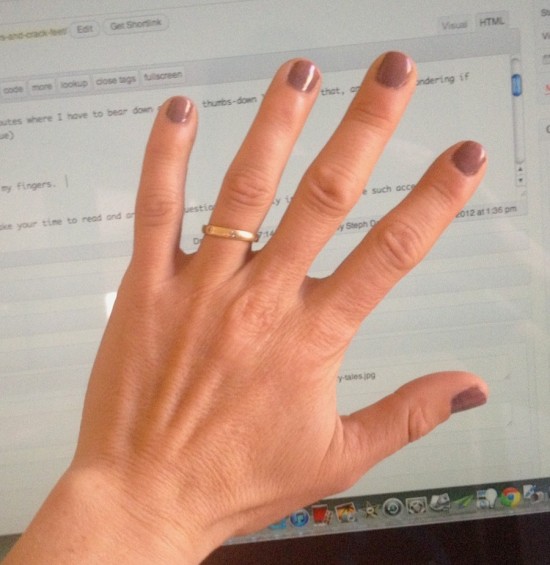
This is what they were looking like yesterday.
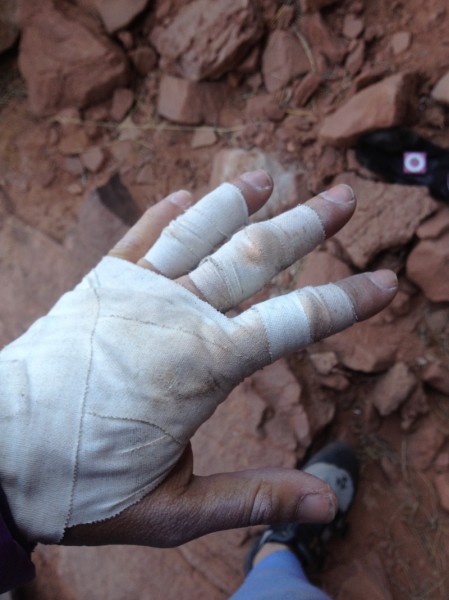
I don’t know. I think they’re okay….but now that you mention it, I have seen a lot of very twisted fingers and big knuckles on my friends who sport climb a lot. So that’s pretty strange because they are not sticking their fingers in cracks. It’s possible that putting all of one’s body weight on fingers year after year may lead to them getting a little torqued. Or at least looking different from “normal” people’s.
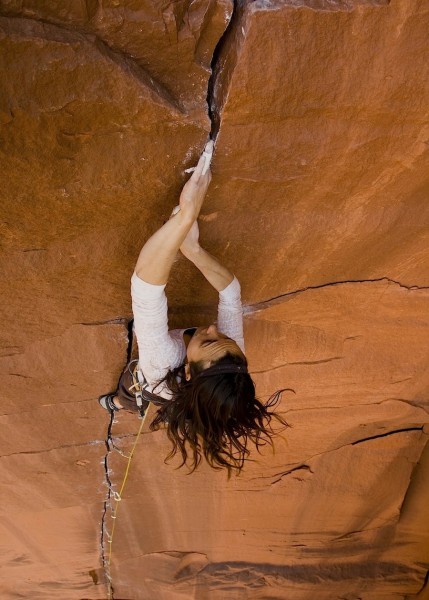
But I know I twist and crank quite a bit on my fingers, and although it makes them hurt, I don’t think they are permanently stuck that way (I may be in denial–but you can draw your own conclusions from the hand photo!). My knuckles tend to be swollen during crack season, but I actually consider that a good thing since so many of the hard cracks are rattly finger sized for me.
Anyway, not to be too blase, but I would say don’t worry about it toooo much. But you should check in with a doctor if it becomes a big concern.
Steph
Hi Steph. It is so gracious of you to take your time to read and answer our questions – it really is unique to have such access to expert knowledge. Thank you!
Questions:
1. you’ve written that both feet should always be in the crack. As soon as you step up, that that lower foot should go back into the crack at knee level even if it’s just resting and not weight bearing. But I find that when the climbing gets difficult for me in thin cracks, I prefer to take my lower foot completely out of the crack after I’ve stepped up on the upper foot, and just dangle it off in freespace out to the side – because then my crackfoot leg can be vertical, and my hips come in nice and tight to the wall so that all my weight is directed down, and not backwards. Are there times that you do the same? If not, do you have any tips for keeping your weight directed so that it’s down over your feet and not pulling you back off the wall?
2. a continuation of the first question, but I couldn’t figure out how to ask it all at the same time. When the crack narrows further (thin thin hands or ratchet-size), with only having one weightbearing foot in the crack, I don’t seem to get enough traction to keep all my weight on my foot, and so I fight either sliding down the crack and falling out, or having to support a portion of my weight with my hands. So I know that I have to have both feet in and camming, but like I said above, that tends to stick my hips out away from the wall and pull backward on my hands. You’ve already given me the answer in your Thin to Win article: that your feet “must stay high to stick. Your body position is that of a ballerina doing a plie, or a frog”, but I’m having trouble (I’m really struggling 🙂 with the biomechanics of this.
I took videos of myself climbing a thin hands crack. I don’t know if you can see any of the things I talked about but it goes like this:
Easy! Unused foot dangling out of the crack: https://www.youtube.com/watch?v=gtdAyyMMUH4
Starting to be a struggle! Foot goes in at knee level immediately: https://www.youtube.com/watch?v=9CqugIqgvEc
OMG Hard! Feet like a frog: https://www.youtube.com/watch?v=4q_rgOogS70
Would love to hear your thoughts.
Happy holidays,
Jonathan
ps. I took your 2.5 hour crack climbing clinic in Seattle when you visited about a year ago. I had never been in a crack before, and now it’s hard to believe how much of a good time I am having climbing cracks. I also enjoy getting to tell people that I learned from the best, and then sharing your techniques with them.
pss. I’ll be coming to Indian Creek this spring, I would love to see you there. (the dates for your 3/15-17 clinic don’t work though)
Jonathan
Hi Jonathan,
Sorry you can’t make it to the Indian Creek weekend 🙂
About the feet: as you’re discovering, the rule of getting both feet in as much as possible is not hard and fast. There are a lot of times you will not have both feet in all the time–most commonly if the crack is angling at all. Sometimes taking one foot out and leaning your body to the side allows you to change the weight on your hands and recover a little.
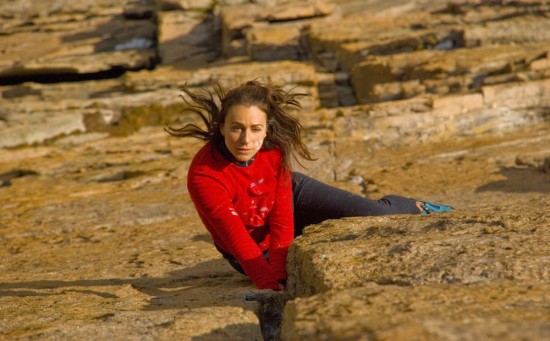
But as a general rule, when the crack is sustained and not angling, without a lot of outside features to work with, having both feet in the crack as much as possible will allow you to get more weight off your arms.
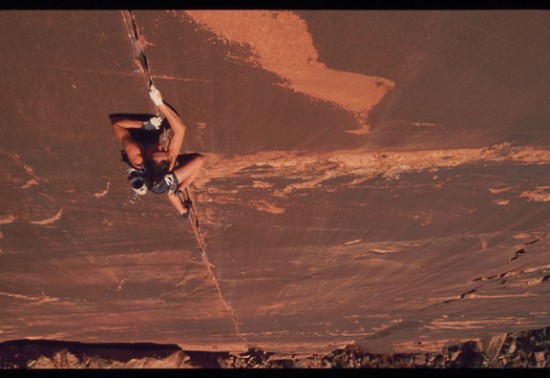

But your explanation reminded me of a time when I climbed a lot with Ron Kauk in Yosemite and Tuolomne. Ron is one of the most incredible climbers I’ve ever seen, especially on the hard Yosemite granite. By working on routes with him and copying his beta, I realized that a lot of the time I thought I was limited by strength, but in fact it was by lack of hip flexibility. Ron seems to have hips as flexible as a lizard’s, so he can put the tip of his shoe up on a tiny crystal and just suck his entire body directly upwards off it. Before I got smart enough to start copying everything he did, I was falling off all the cruxes on the routes we’d work together, because I was trying to pull up really hard on awful holds and finding it totally impossible. Invariably, Ron would stick his toe up on a crystal and suck his body directly up the wall in those sections. It took a lot of stretching for me to even begin to have enough hip flexibility to try moves the way he did them, but once I did, it really changed the way I climbed.

Pure crack climbing has almost opposite flexibility demands for some body parts than face climbing does, so one pretty likely possibility is that your legs, ankles and hips are not yet wanting to do what you’re wanting them to do. When trying to keep both feet in on splitters, you do need to be able to pull your hips in pretty close to be balanced over both feet. If your hips are not wanting to open that way, or if your ankles do not like to bend in the ankle-spraining position, then you will find it less strenuous to just stay over one leg (which is fine if that is what works in the moment!).
Good luck, and I’m glad you have turned into a crack junkie! Steph








Thank you for the suggestion to work on hip flexibility: I would never have thought about that! Do you have examples of the kind of stretches you’d recommend?
Always grateful,
Jonathan
Try starting with basic hip openers: sitting with feet together and knees out. Then you can work on lying backward with your legs like that. The most extreme is to lie on your stomach with your legs out in a frog position, feet flat against a wall and some magazines or wool socks under your knees (depending on the floor surface) to allow them to slide out. Be careful with this one though.